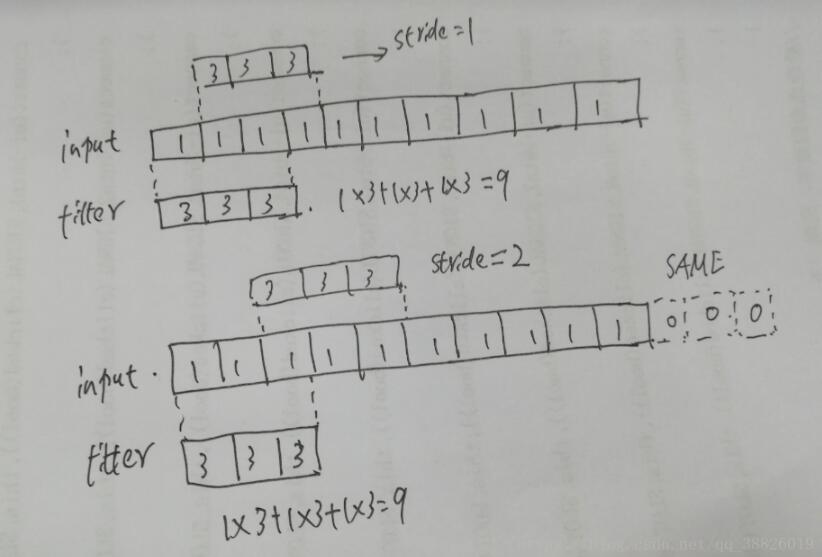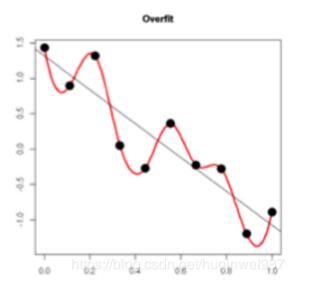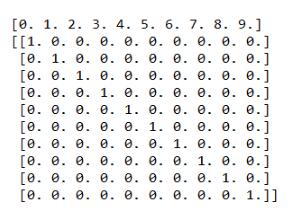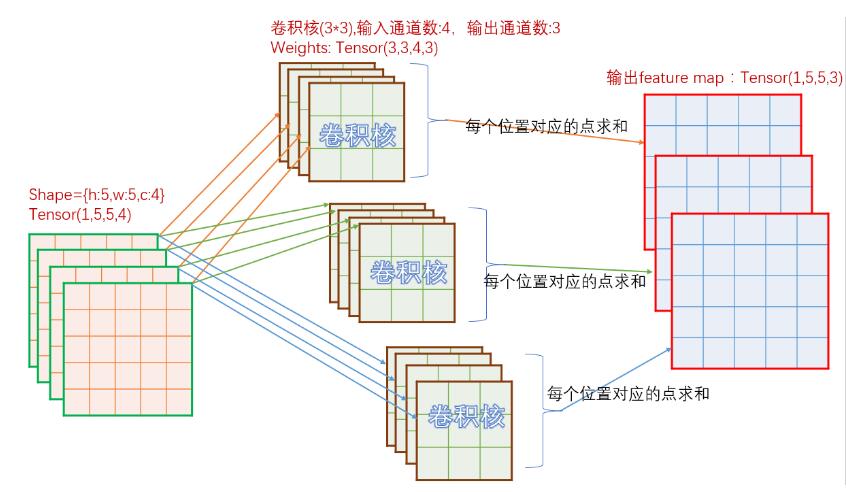分类:tensorflow
2020
09-29
一般TensorFlow中扩展维度可以使用tf.expand_dims()。近来发现另一种可以直接运用取数据操作符[]就能扩展维度的方法。用法很简单,在要扩展的维度上加上tf.newaxis就行了。foo=tf.constant([[1,2,3],[4,5,6],[7,8,9]])print(foo[tf.newaxis,:,:].eval())#=>[[[1,2,3],[4,5,6],[7,8,9]]]print(foo[:,tf.newaxis,:].eval())#=>[[[1,2,3]],[[4,5,6]],[[7,8,9]]]print(foo[:,:,tf.newaxis].eval())#=>[[[1],[2]...
继续阅读 >
2020
09-29
 tf.tile()应用于需要张量扩展的场景,具体说来就是:如果现有一个形状如[width,height]的张量,需要得到一个基于原张量的,形状如[batch_size,width,height]的张量,其中每一个batch的内容都和原张量一模一样。tf.tile使用方法如:tile(input,multiples,name=None)importtensorflowastfa=tf.constant([7,19])a1=tf.tile(a,multiples=[3])#第一个维度扩充3遍b=tf.constant([[4,5],[3,5]])b1=tf.tile(b,multiples...
继续阅读 >
tf.tile()应用于需要张量扩展的场景,具体说来就是:如果现有一个形状如[width,height]的张量,需要得到一个基于原张量的,形状如[batch_size,width,height]的张量,其中每一个batch的内容都和原张量一模一样。tf.tile使用方法如:tile(input,multiples,name=None)importtensorflowastfa=tf.constant([7,19])a1=tf.tile(a,multiples=[3])#第一个维度扩充3遍b=tf.constant([[4,5],[3,5]])b1=tf.tile(b,multiples...
继续阅读 >
 我就废话不多说了,大家还是直接看代码吧!importtensorflowastfimportnumpyasnpinput=tf.constant(1,shape=(64,10,1),dtype=tf.float32,name='input')#shape=(batch,in_width,in_channels)w=tf.constant(3,shape=(3,1,32),dtype=tf.float32,name='w')#shape=(filter_width,in_channels,out_channels)conv1=tf.nn.conv1d(input,w,2,'VALID')#2为步长print(conv1.shape)#宽度计算(width-kernel_size+1)/strides,(10-3...
继续阅读 >
我就废话不多说了,大家还是直接看代码吧!importtensorflowastfimportnumpyasnpinput=tf.constant(1,shape=(64,10,1),dtype=tf.float32,name='input')#shape=(batch,in_width,in_channels)w=tf.constant(3,shape=(3,1,32),dtype=tf.float32,name='w')#shape=(filter_width,in_channels,out_channels)conv1=tf.nn.conv1d(input,w,2,'VALID')#2为步长print(conv1.shape)#宽度计算(width-kernel_size+1)/strides,(10-3...
继续阅读 >
 我就废话不多说了,大家还是直接看代码吧!model=keras.models.Sequential([#卷积层1keras.layers.Conv2D(32,kernel_size=5,strides=1,padding="same",data_format="channels_last",activation=tf.nn.relu,kernel_regularizer=keras.regularizers.l2(0.01)),#池化层1keras.layers.MaxPool2D(pool_size=2,strides=2,padding="same"),#卷积层2keras.layers.Conv2D(64,kernel_size=5,strides=1,padding="same",data_format="c...
继续阅读 >
我就废话不多说了,大家还是直接看代码吧!model=keras.models.Sequential([#卷积层1keras.layers.Conv2D(32,kernel_size=5,strides=1,padding="same",data_format="channels_last",activation=tf.nn.relu,kernel_regularizer=keras.regularizers.l2(0.01)),#池化层1keras.layers.MaxPool2D(pool_size=2,strides=2,padding="same"),#卷积层2keras.layers.Conv2D(64,kernel_size=5,strides=1,padding="same",data_format="c...
继续阅读 >
2020
09-27
2020
09-27
2020
09-27
 背景:目前keras框架使用简单,很容易上手,深得广大算法工程师的喜爱,但是当部署到客户端时,可能会出现各种各样的bug,甚至不支持使用keras,本文来解决的是将keras的h5模型转换为客户端常用的tensorflow的pb模型并使用tensorflow加载pb模型。h5_to_pb.pyfromkeras.modelsimportload_modelimporttensorflowastfimportosimportos.pathasospfromkerasimportbackendasK#路径参数input_path='inputpath'weight_...
继续阅读 >
背景:目前keras框架使用简单,很容易上手,深得广大算法工程师的喜爱,但是当部署到客户端时,可能会出现各种各样的bug,甚至不支持使用keras,本文来解决的是将keras的h5模型转换为客户端常用的tensorflow的pb模型并使用tensorflow加载pb模型。h5_to_pb.pyfromkeras.modelsimportload_modelimporttensorflowastfimportosimportos.pathasospfromkerasimportbackendasK#路径参数input_path='inputpath'weight_...
继续阅读 >

 一,直接保存pb1,首先我们当然可以直接在tensorflow训练中直接保存为pb为格式,保存pb的好处就是使用场景是实现创建模型与使用模型的解耦,使得创建模型与使用模型的解耦,使得前向推导inference代码统一。另外的好处就是保存为pb的时候,模型的变量会变成固定的,导致模型的大小会大大减小。这里稍稍解释下pb:是MetaGraph的protocolbuffer格式的文件,MetaGraph包括计算图,数据流,以及相关的变量和输入输出主要使用tf.SavedM...
一,直接保存pb1,首先我们当然可以直接在tensorflow训练中直接保存为pb为格式,保存pb的好处就是使用场景是实现创建模型与使用模型的解耦,使得创建模型与使用模型的解耦,使得前向推导inference代码统一。另外的好处就是保存为pb的时候,模型的变量会变成固定的,导致模型的大小会大大减小。这里稍稍解释下pb:是MetaGraph的protocolbuffer格式的文件,MetaGraph包括计算图,数据流,以及相关的变量和输入输出主要使用tf.SavedM...
 L2正则化原理:过拟合的原理:在loss下降,进行拟合的过程中(斜线),不同的batch数据样本造成红色曲线的波动大,图中低点也就是过拟合,得到的红线点低于真实的黑线,也就是泛化更差。可见,要想减小过拟合,减小这个波动,减少w的数值就能办到。L2正则化训练的原理:在Loss中加入(乘以系数λ的)参数w的平方和,这样训练过程中就会抑制w的值,w的(绝对)值小,模型复杂度低,曲线平滑,过拟合程度低(奥卡姆剃刀),参考公式...
L2正则化原理:过拟合的原理:在loss下降,进行拟合的过程中(斜线),不同的batch数据样本造成红色曲线的波动大,图中低点也就是过拟合,得到的红线点低于真实的黑线,也就是泛化更差。可见,要想减小过拟合,减小这个波动,减少w的数值就能办到。L2正则化训练的原理:在Loss中加入(乘以系数λ的)参数w的平方和,这样训练过程中就会抑制w的值,w的(绝对)值小,模型复杂度低,曲线平滑,过拟合程度低(奥卡姆剃刀),参考公式...
 tf.tile()应用于需要张量扩展的场景,具体说来就是:如果现有一个形状如[width,height]的张量,需要得到一个基于原张量的,形状如[batch_size,width,height]的张量,其中每一个batch的内容都和原张量一模一样。tf.tile使用方法如:tile(input,multiples,name=None)importtensorflowastfa=tf.constant([7,19])a1=tf.tile(a,multiples=[3])#第一个维度扩充3遍b=tf.constant([[4,5],[3,5]])b1=tf.tile(b,multiples...
tf.tile()应用于需要张量扩展的场景,具体说来就是:如果现有一个形状如[width,height]的张量,需要得到一个基于原张量的,形状如[batch_size,width,height]的张量,其中每一个batch的内容都和原张量一模一样。tf.tile使用方法如:tile(input,multiples,name=None)importtensorflowastfa=tf.constant([7,19])a1=tf.tile(a,multiples=[3])#第一个维度扩充3遍b=tf.constant([[4,5],[3,5]])b1=tf.tile(b,multiples...
 将数据标签变为类似MNIST的one-hot编码形式defone_hot(indices,depth,on_value=None,off_value=None,axis=None,dtype=None,name=None):"""Returnsaone-hottensor.Thelocationsrepresentedbyindicesin`indices`takevalue`on_value`,whileallotherlocationstakevalue`off_value`.`on_value`and`off_value`musthavematchingdatatypes.If`dtype`isalsoprovided,theymustbethe...
将数据标签变为类似MNIST的one-hot编码形式defone_hot(indices,depth,on_value=None,off_value=None,axis=None,dtype=None,name=None):"""Returnsaone-hottensor.Thelocationsrepresentedbyindicesin`indices`takevalue`on_value`,whileallotherlocationstakevalue`off_value`.`on_value`and`off_value`musthavematchingdatatypes.If`dtype`isalsoprovided,theymustbethe...
 从一个通道的图片进行卷积生成新的单通道图的过程很容易理解,对于多个通道卷积后生成多个通道的图理解起来有点抽象。本文以通俗易懂的方式讲述卷积,并辅以图片解释,能快速理解卷积的实现原理。最后手写python代码实现卷积过程,让Tensorflow卷积在我们面前不再是黑箱子!注意:本文只针对batch_size=1,padding='SAME',stride=[1,1,1,1]进行实验和解释,其他如果不是这个参数设置,原理也是一样。1Tensorflow卷积实现原理先看...
从一个通道的图片进行卷积生成新的单通道图的过程很容易理解,对于多个通道卷积后生成多个通道的图理解起来有点抽象。本文以通俗易懂的方式讲述卷积,并辅以图片解释,能快速理解卷积的实现原理。最后手写python代码实现卷积过程,让Tensorflow卷积在我们面前不再是黑箱子!注意:本文只针对batch_size=1,padding='SAME',stride=[1,1,1,1]进行实验和解释,其他如果不是这个参数设置,原理也是一样。1Tensorflow卷积实现原理先看...
 我就废话不多说了,大家还是直接看代码吧!importtensorflowastfimportnumpyasnpinput=tf.constant(1,shape=(64,10,1),dtype=tf.float32,name='input')#shape=(batch,in_width,in_channels)w=tf.constant(3,shape=(3,1,32),dtype=tf.float32,name='w')#shape=(filter_width,in_channels,out_channels)conv1=tf.nn.conv1d(input,w,2,'VALID')#2为步长print(conv1.shape)#宽度计算(width-kernel_size+1)/strides,(10-3...
我就废话不多说了,大家还是直接看代码吧!importtensorflowastfimportnumpyasnpinput=tf.constant(1,shape=(64,10,1),dtype=tf.float32,name='input')#shape=(batch,in_width,in_channels)w=tf.constant(3,shape=(3,1,32),dtype=tf.float32,name='w')#shape=(filter_width,in_channels,out_channels)conv1=tf.nn.conv1d(input,w,2,'VALID')#2为步长print(conv1.shape)#宽度计算(width-kernel_size+1)/strides,(10-3...
 我就废话不多说了,大家还是直接看代码吧!model=keras.models.Sequential([#卷积层1keras.layers.Conv2D(32,kernel_size=5,strides=1,padding="same",data_format="channels_last",activation=tf.nn.relu,kernel_regularizer=keras.regularizers.l2(0.01)),#池化层1keras.layers.MaxPool2D(pool_size=2,strides=2,padding="same"),#卷积层2keras.layers.Conv2D(64,kernel_size=5,strides=1,padding="same",data_format="c...
我就废话不多说了,大家还是直接看代码吧!model=keras.models.Sequential([#卷积层1keras.layers.Conv2D(32,kernel_size=5,strides=1,padding="same",data_format="channels_last",activation=tf.nn.relu,kernel_regularizer=keras.regularizers.l2(0.01)),#池化层1keras.layers.MaxPool2D(pool_size=2,strides=2,padding="same"),#卷积层2keras.layers.Conv2D(64,kernel_size=5,strides=1,padding="same",data_format="c...
 一、前提:有Google账号(具体怎么注册账号这里不详述,大家都懂的,自行百度)在你的Google邮箱中关联好colab(怎样在Google邮箱中使用colab在此不详述,自行百度)二、现在开始:因为我们使用的是colab,所以就不必为安装版本对应的anaconda、python以及tensorflow尔苦恼了,经过以下配置就可以直接开始使用了。在colab中新建代码块,运行以下代码来下载需要的数据集#InthisexerciseyouwilltrainaCNNontheFULLCats...
一、前提:有Google账号(具体怎么注册账号这里不详述,大家都懂的,自行百度)在你的Google邮箱中关联好colab(怎样在Google邮箱中使用colab在此不详述,自行百度)二、现在开始:因为我们使用的是colab,所以就不必为安装版本对应的anaconda、python以及tensorflow尔苦恼了,经过以下配置就可以直接开始使用了。在colab中新建代码块,运行以下代码来下载需要的数据集#InthisexerciseyouwilltrainaCNNontheFULLCats...
 Tensorflow编程系统Tensorflow工具或者说深度学习本身就是一个连贯紧密的系统。一般的系统是一个自治独立的、能实现复杂功能的整体。系统的主要任务是对输入进行处理,以得到想要的输出结果。我们之前见过的很多系统都是线性的,就像汽车生产工厂的流水线一样,输入->系统处理->输出。系统内部由很多单一的基本部件构成,这些单一部件具有特定的功能,且需要稳定的特性;系统设计者通过特殊的连接方式,让这些简单部件进行连接,以...
Tensorflow编程系统Tensorflow工具或者说深度学习本身就是一个连贯紧密的系统。一般的系统是一个自治独立的、能实现复杂功能的整体。系统的主要任务是对输入进行处理,以得到想要的输出结果。我们之前见过的很多系统都是线性的,就像汽车生产工厂的流水线一样,输入->系统处理->输出。系统内部由很多单一的基本部件构成,这些单一部件具有特定的功能,且需要稳定的特性;系统设计者通过特殊的连接方式,让这些简单部件进行连接,以...
 1.创建图在tensorflow中,一个程序默认是建立一个图的,除了系统自动建立图以外,我们还可以手动建立图,并做一些其他的操作。下面我们使用tf.Graph函数建立图,使用tf.get_default_graph函数来获取图,使用reset_default_graph对图进行重置。importtensorflowastfimportnumpyasnpc=tf.constant(1.5)g=tf.Graph()withg.as_default():c1=tf.constant(2.0)print(c1.graph)print(g)print(c.graph)g2=tf.get_de...
1.创建图在tensorflow中,一个程序默认是建立一个图的,除了系统自动建立图以外,我们还可以手动建立图,并做一些其他的操作。下面我们使用tf.Graph函数建立图,使用tf.get_default_graph函数来获取图,使用reset_default_graph对图进行重置。importtensorflowastfimportnumpyasnpc=tf.constant(1.5)g=tf.Graph()withg.as_default():c1=tf.constant(2.0)print(c1.graph)print(g)print(c.graph)g2=tf.get_de...